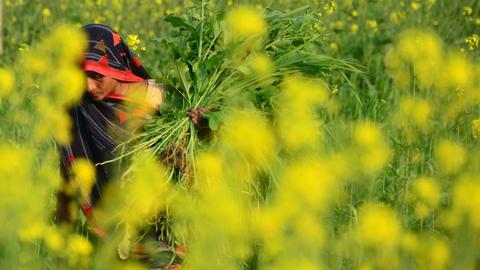HARYANA, INDIA – Jaibuna, 45, spends each day on her farmland, a sloped field in Biwan village near the Haryana-Rajasthan border in north India, overlooking the Aravalli mountains. She plants and harvests multiple crops at once: broccoli, tomatoes, onions, potatoes, eggplant, gourd, beet root, and chili pepper. With monsoons around the corner, she checks the produce every morning for any disease.
A mother of eight children — four sons and four daughters — Jaibuna is a smallholder landless multi-layer farmer. Multi-layer farming is a process of growing different types of crops, mostly vegetables and fruits on the same land and at the same time. After her husband’s death in 2018 due to a lung infection, she quickly learned farming. Her husband, Khursheed Ahmed, farmed for years on rented land. Ahmed, who previously worked as a labourer in mines near his village, developed tuberculosis. When mining in the Aravalli mountain range was banned by the Supreme Court of India in 2002, Ahmed switched to farming.
But life was difficult for his family.
“And when he died, he left nothing behind for us,” Jaibuna says.
This meant Jaibuna had to defy generations-old cultural norms to socially isolate herself after being widowed.
“I chose to take control of my life and make my own decisions.”
Jaibuna, who prefers not to use her husband’s last name, now grows a variety of vegetables on the same plot in all four seasons.
In 2018-2019, Jaibuna was the first woman farmer in Haryana state to get land on a lease for cultivation.
Before her, there were cultural and societal barriers against passing ownership of land, either temporary or permanent, to women.
Out of 110 households in her village, more than 80 young women have been widowed. Most of the men have died of tuberculosis after having worked for years in mining quarries.
Speaking about tuberculosis is a social stigma here. Yet, women do not want the new generation to shoulder the burden of their economic requirements.
Instead, they are taking a lead in earning a sustainable income through farming for their families. Cases like these have been celebrated in popular discourse as feminisation of agriculture.
But, such agrarian practices — where women’s growing contribution of labour in agriculture has substantially increased — undermine women’s wellbeing in the long run, in what researchers in India call feminisation of agrarian distress.
In fact, according to Oxfam, one-third of female farmers in India are unpaid labourers on family farms owned by their parents, husbands, or in-laws.
The World Bank has made gender equity in the agriculture and food sector a specific goal and is working to expand women’s access to land and rural finance.
Farmers in India have been at the receiving end of a severe agrarian crisis: rising debt following failed harvests, declining plot sizes, water scarcity, falling prices of agricultural yield and degraded soils.
As a result, many have been forced to take their own lives. Indian farmers recorded the highest number of suicides in the past five years, with a 3.4 percent increase in the number of cases in 2019 from 2018, according to National Crime Records Bureau (NCRB).
Bankruptcy and poverty have been flagged by the NCRB as the principal reasons for the incidence of suicides among farmers.
Against this grim backdrop, thousands of farmers have been camping at several locations near the capital in Delhi since last November, demanding the repeal of three new farm laws introduced by the government while demanding a legal guarantee on Minimum Support Prices (MSP) for their crops.
For farmer leaders, the new laws favour market forces and must go.


Comment here